Joiners Work
Period records about their work
[a free-to-all long post looking at some period records about joiners’ work. Snippets here & there - usually more questions than answers about research like this. But that’s part of the fun…]
My previous post was about how I begin making a joined chest - figuring the sizes, mortise placements, panel dimension, etc. And I digressed into critique of some writers who try to explain how period joiners arrived at those same decisions. Speculation always bothers me. I’ve tried to pull out the few examples I know of about interactions between period joiners and their customers. Carpenters often had written documents outlining what’s expected of them - a larger project than household furniture, thus more money, thus more at stake. Get it in writing.
One well known (to some) example took place in Essex County, Massachusetts. I might have gone over this before, in which case, sorry for repeating myself. It’s a court case, complete with depositions from people who witnessed some of the interaction. I’ll intersperse my comments.
Writ: John Davis v. John Tolly; debt; for four wainscot chests made by his order and delivered to him in his house, dated June 23, 1681; signed by John Fuller, for the court and town of Lyn; and served by Richard Prytherch, constable of Salem, by attachment of the bed of the defendant, the summons being left with Mrs. Tauly.
Nathaniall Kirtland, aged about thirty-four years, deposed that he brought from John Davis’ shop at Lyn four chests and delivered them to John Tauly at his house in Salem. Davis told the deponent that Tauly had them to carry to Newfoundland. Sworn in court.
Bill of cost 3£
So far we know that John Davis was the joiner in Lynn and he made four chests for John Tolly. Delivered by Nathaniel Kirtland.
Eleaser Lenesey, aged about thirty-five years, deposed that Davis looked at a chest in Tawleay’s house and the latter told him to make two or three as good as that for 25s. each. Sworn in court before William Browne, assistant, and owned in court.
Ah, even better. Tolly showed a chest to Davis & asked him to make some “as good as that.” So that’s as much as we know about the customer’s input.
Richard Croade, aged about fifty-two years, testified that, on May 7, 1681, he heard Mr John Tally read from his book his account with John Davis, and the latter did not disown it. Sworn, May 11, 1681, before William Browne, assistant.
At first I thought it was the joiner who kept a book, but it’s the customer, Tolly. (or Tawley, etc).
Samll Blyghe, aged about twenty-two years, deposed that, being in the house of Mr Wing of Boston in company with John Tawly of Salem and Joseph Cawly, he heard Tawly ask John Davis, joiner, of Lynn, to make the chests, saying he would rather Davis have his money than any one else, at the same time giving him 5s. Sworn, June 23, 1681, before William Browne, assistant.
Another witness to the order for the chests. Now with a deposit.
John Longley, aged about forty-two years, testified that on May 6, 1681, he heard Davis at Taulely’s house call the latter a cheating knave, with many other absurd expressions, challenging him out of his own house to fight, threatening him. He also took hold of a wainscot chest in the room, threw it up and down the room, breaking several pieces of the front of the chest, etc. Davis was very much in drink. Elizabeth Tawley testified to the same. Sworn, June 28, 1681 before Bartho Gedney, assistant.
Now the joiner, John Davis, “very much in drink” is throwing a tantrum - but we don’t know in what way Tolly was cheating him. I assume it’s about payment, what else could it be? He threw a wainscot chest up & down the room, breaking several pieces of the front...I wonder if these are applied decoration - or did he somehow break the framing? Seems more likely to break off applied stuff.
Joseph Calley, aged about thirty-seven years, deposed. Sworn, June 7, 1681, before John Richards, assistant.
Eleazer Lenesey, aged about thirty-five years, testified that, being in John Davis’ house at Line, after he had brought home the cloth, a whole piece of kersey, he said he had bought it of John Tawleay of Salem. Sworn before William Browne, assistant.
Mary Ivory, aged about forty-two years, deposed that she was at Taulie’s house when he received the chests. Sworn in court.
Samuell Ingols, aged about twenty-seven years, and Nathanil Willson, aged about nineteen years, deposed that the chests were worth 30s. each. Sworn in court.
John Longley, aged about forty-two years, and Thomas Eleat, aged about twenty-six years, deposed concerning the assault and that neither Tawley nor his wife could have any peace while Davis was in the house. Sworn. May 9, 1681, before Bartho Gedney, assistant.”
So this flurry of depositions confirms that the chests arrived at Tolly’s house, that they were worth 30 shillings each and that Davis assaulted Tolly. The bit about Davis coming home with a piece of cloth - “a whole piece of kersey” - is interesting, but lacking some details. Seems unlikely in the midst of this kerfuffle that Tolly would then sell Davis a piece of cloth. Did he take it as partial payment? We’ll never know. There was no more about the case in the Essex County Court Records that I ever saw. This excerpt was published in George Francis Dow, Records and Files of the Quarterly Court Essex County, Massachusetts, 8 volumes, (Salem, Massachusetts: Essex Institute, 1911-21) v8, pp. 123-125.
[for reference, a chest attributed to the Symonds shop in Salem, the most dominant shop in that busy port town]:
As an aside, those Essex County Court records were transcribed and summarized in the early 20th century, published in 8 or 9 volumes. They’re a fascinating look at life in that period. If you want to really delve deeply into the subject - they’re available in a few places online - here’s the one I’ve been using lately https://catalog.hathitrust.org/Record/102425964
The Davis/Tawley case is a situation where details come down to us because things went badly - so everyone ended up in court. Another case has some specifics recorded, but this time just because it was a large enough job to require a contract. From Boston, dated 1685:
Articles of Agreement Indented concluded the [blank] Day of Decemb anno Dom One Thousand Six hundred Eighty and ffive Between John White of Boston in New England joynor on the one part and Arthur Tanner of Boston afforesd marriner on the other part are as ffolloweth Imp[rimi]s The s[ai]d William [John?] White for the considerations herein exprest doth Covenant promise bind and oblige himself his heires estate and adm[inistrator]s to doe and performe all Such joynors worke in and upon the Ship Which william Greenough is now building for the sd Tanner on the Stocks in Sd Greenoughs Building yard as is herein mentioned & expressed.
vizt:
To Plane and rabbit the upright of the Sterne
To Plane and rabbitt all necessaryes for the Territts
To Plane the great cabbin Deck
To make a Bulkhead & doors to that cabbin
With two Close cabbins & settlebed with turn'd ballasters and a Table in three parts with a Cupboard & all Lockers convenient with Shutters for the light and to ceile it after the best manner
To Imbow [i.e., run a molding upon] all railes that shall be placed on sd Ship with a ffife-raile
To Ceile [ceiling; a synonym for joining] the roundhouse & make in it two Cabbins and a Table with Lockers, and too lights wth Shutters to them
To plane the Bulkeheads & make a table on the Quarter Deck: and Chaire & binacle with Hen Coops convenient
To Plane the planks in the Steeridge & round the beames & to make foure hanging Cabbins and a binnacle with one Close Locker with a Lock to the Same
To make foure close Cabbins between decks & a Saile room wth a grateing bulkehead for the gun roome & to round the beames
To Plaine the Bulk head of the Steeridge & the Innboard plank along the side to make all such Gangways the master sees meet.
To plane all Gunwales & round house & bulk head of the forecastle & to make in the forecastle two Cabbins and Two Lockers & to plane the planks of the Beakc hedd All which abovementioned worke with what more Joynors work fill for sd Ship & not herein mentioned is to be done and finished to the masters content and in good and workemanlike order in every respect by the ffifteenth day of may next ensuing the day of the date hereof if required.
That’s copied into Benno Forman’s book American Seating Furniture 1630-1730, (New York: W.W. Norton & Co., 1988) p. 43. Most of that is over my head, not being a nautically-inclined person. “Ceiling” a space is usually meant to indicate wainscot paneling. Joiners were often called “joiner-ceilers” slightly earlier. “Good and workmanlike order” is a standard sort of phrase found in period documents. Vague enough to leave some room for interpretation.
...................
An English record is one I’ve always enjoyed - from a daybook of a Yorkshire farmer Henry Best. These two related entries from Rural Economy in Yorkshire in 1641: Being the Farming and Account Books of Henry Best, of Elmswell, in the East Riding of the County of York (Durham: published by the Camden Society, 1857)
1620, April 4. Agreed with Matthewe Carter, for paylinge the swyne stye with sawen ashe pales, to give him for his worke 9d [per] yeardes, and hee is to sawe them, and to saw the rayles and postes, and sett them in a groundsell, and rabbitt them into the rayle above; agreed also with him to pale the yearde, and hee is to sawe the rayles and postes, and to have 4d per yearde, for his labor, and for making Austin’s howse. 20s.
Dec 13 [1623] Bargained with Matthewe Carter and John Carter his sonne, of Greate Driffeylde, carpenters, to digg upp a walnutt tree of myne, and sawe it into 2 ynch and a halfe plankes, and the rest of the small peeces into such peeces it is fittest for; and to make mee two chayres, one for my selfe, and the other a lesser, well turned and wrought, and I am to give them for doing these things above mencioned, workman like, 10s in money, a bushell [8 gallons] of barley, and a pecke [2 gallons] of oatmeal, and give them in money 3d for their godspenny.”
The range of work - from a pigstye to “well turned and wrought” walnut chairs - is pretty broad. Also interesting that they’re digging up, not cutting down, the walnut tree. And that these men are termed carpenters is even more revealing. Now if we only knew what “Austin’s howse” is...
.....................
Back to the Essex County records - v 2, pp. 266-267: Ipswich, Mar 1661:
Contract made, Sept. 27, 1659, with William Averell, carpenter, by Richard Jacob, both of Ipswich: Said Averell was to erect a building 18 feet square and 13 feet stud, to provide clapboards and shingles for the said building and to lay them; to lay three floors with joist and board; to “make 4 windows too stole windows of 5 Lights apeece and to Claristory windows of 4 Lights apeece also a garret window to Casments betwene studs pertitions and dors to Close the Roms Compleat as allso to Remoue A Little Rome and Close it to his house and mak it tite betwene allso to make a table and frame of 12 or 14 foot Long and a joyned forme of 4 foot Long and a binch Behind the table.” The amount paid was twelve pounds, and Averell agreed to have the work completed by the last of August. Said Jacob agreed to draw all the timber and board for the covering and to send convenient help to raise frens and boards and nails. Said Averell was to make good all timber which was found defective through him, so as to have the house substantial. Wit: John Appleton and John (his mark) Gage.
Thomas Whittered deposed that, being at work at Sargant Richerd Jacob’s house the latter end of last summer, the latter hired deponent to hew a “grounsill” and mortice it, to put into the side of his old house which stood where the new house was to be set. The “grounsill” of the old house, he said, was rotten and the new sill had not been put in yet, though he worked by the day and was not engaged to put it in. “The house as it then stood and still Remains is incapable of being Remoued as I conceive : I furder Testify that the frame of the new house did not want much of being fitt to Raise when I was there att worke about the grounsill: also there was a considerable quantity of shingles and clapboard for covering then brought out and still piled up in sargant Jacobs yard done by william auerell as I am a wittnes of allso the celler that the ould house is to stand ouer is without sleepers open to this day.” Sworn in Ipswich court, Mar. 26, 1661, before Robert Lord, clerk.
William Goodhue testified that, going by William Avery’s not long since, Sergant Jacob asked Avery if he would not go on with his work, and he said that he would if Avery would come to new terms. Sworn in court, before Robert Lord, clerk.
Thomas and Sammuell Jacob, aged about twenty and twenty‑two years, sons of Richard Jacob, deposed that there was a sill ready for the old house, and the reason that it was not put in, was because the walls should not be broken down before the other house was ready to be set up. Sworn in Ipswich court, Mar. 26, 1661, before Robert Lord, clerk.
Thomas Clarke, of Noddle’s Illand, deposed that he cleft out for William Averell about 1200 clapboards and shingles in Richerd Jacobs’ yard, about the time the jurymen were chosen for last September court, some of which clapboard stuff was brought home to Sarg. Jacobs’ house while he was there at work. Sworn before Robert Lord, clerk.
The initial contract in which Averill was hired to do a lot of carpentry work as well as making the table, form and bench is often quoted in treatments of New England furniture, driving home the point that not all furniture was made by men called “joiner” - it was often the work of a “carpenter.” Usually the quotes just focus on the contract and ignore the fact that the whole thing got mired down in a court case. We don’t know if he ever made the table - from the sounds of it, the house was not finished, so I can’t see how the table would have been necessary.
[George Francis Dow, Records and Files of the Quarterly Court Essex County, Massachusetts, 8 volumes, (Salem, Massachusetts: Essex Institute, 1911-21) v. 2, pp. 266, 267.]
...............
Thomas Dennis appeared in the court records of Essex county a few times, most notably when he had a grant to take 6 trees off the town common and instead took 18.
[from George Francis Dow, Records and Files of the Quarterly Court Essex County, Massachusetts, 8 volumes, (Salem, Massachusetts: Essex Institute, 1911-21) v. 4, p. 349.]
Thomas Dennis, presented for a lie, was fined.
Josias Lyndon deposed that Thomas Dennis went into the woods and chose eighteen trees, and commanded deponent who was his servant, to fell the, which he did in October last. Then he and Denis wrought them out into bolts. This was in Ipswich woods on the south side of the river beyond Goodman Fellowes. Sworn, Apr 6, 1670 before Samuel Symonds.
Thomas Hart, sr., and Walter Roper deposed that they were present when the selectmen sent for Denis for felling twelve trees more than he was allowed. Josias Lyndell’s testimony was read before Dennis but he denied it. Later it was decided that Walter Roper, Edw. Chapman with Tho. Hart and Nathll. Treadwell should go into the woods, and they found the trees felled, but Dennis still denied that he cut them all, although Lindell so affirmed to his face. Sworn in court.
Walter Roper deposed that being informed that Thomas Dennis had felled eighteen trees on the commons and searching the records, found that he had a grant of six and no more, etc. Sworn in court.
Eighteen trees is a lot, no matter the size. There’s no way any joiner needs that many for his trade – the presumption is that some of these were for fencing or clapboards, shingles, etc. But it’s all conjecture, there is no more on the subject, although Dennis appeared in court a number of times.
In Sept 1675 “Thomas Dennis, presented for oppression in his trade, the witness not being in town, was committed to the next court in March” – the footnote says “for a chest and table made for Steven Crost.” - which tells me the original files George Francis Dow was working from had more detail than what’s here. Maybe not much more… v. 6, p. 72.
For me, the best appearance Thomas Dennis made in court concerned a woman named Grace Stout. It seems there were people lining up to claim Grace had stolen money from them. The only thing Thomas Dennis was there for was to testify that she had bought a “carved box with a drawer in it of him in 1679, and it had two locks for which Grace paid him in money.” [v. 8, pp. 279-283]
……………..
Another source for records concerning joiners’ work is town records. There’s rarely much detail, but these often help to identify a man as a joiner (or carpenter). Most often the work revolves around the town’s meeting house. In 1655 the town records for Medfield Massachusetts note payments due to John Houghton for work done on the pulpit of the meeting house:
Due to John hoton for ye Deske & pilers imp for the Deske £7-11-0
It ye tabel 0-11-0
Balister 48 at 7d p piler £1-8-0
2 gred [great] pilers 0-2-0
The “deske” is the pulpit, complete with pillars/balusters. The great pillars are perhaps those that support the raised pulpit. This panel is said to be a fragment that survives from that meeting house:
On April 25, 1694 the town of Braintree recorded “seven shillings to William Savill for dimblebes cofin“ - in this case, not work done upon any town property, but a coffin for one of the town’s poor.
This last one is semi-personal. About 30 years ago, I did some genealogical research and notes from that work include:
Thomas Follansbee (1637‑) was in Portsmouth, N.H. by 1661. He was apparently a joiner because he was paid for “putting up 2 wooden windows at ye meeting house” in 1673/4. Another record cites that “In 1674 his ‘boy’ had done work for the town.” [meaning his apprentice, who may have actually been his son- Thomas Follansbee, Jr became a house-carpenter in Newbury, Massachusetts.] I’ve just spent a couple of hours re-researching this material. I had cited the secondary publications I got those quotes from, but they don’t cite the actual period records and thus far I can’t find those town records.


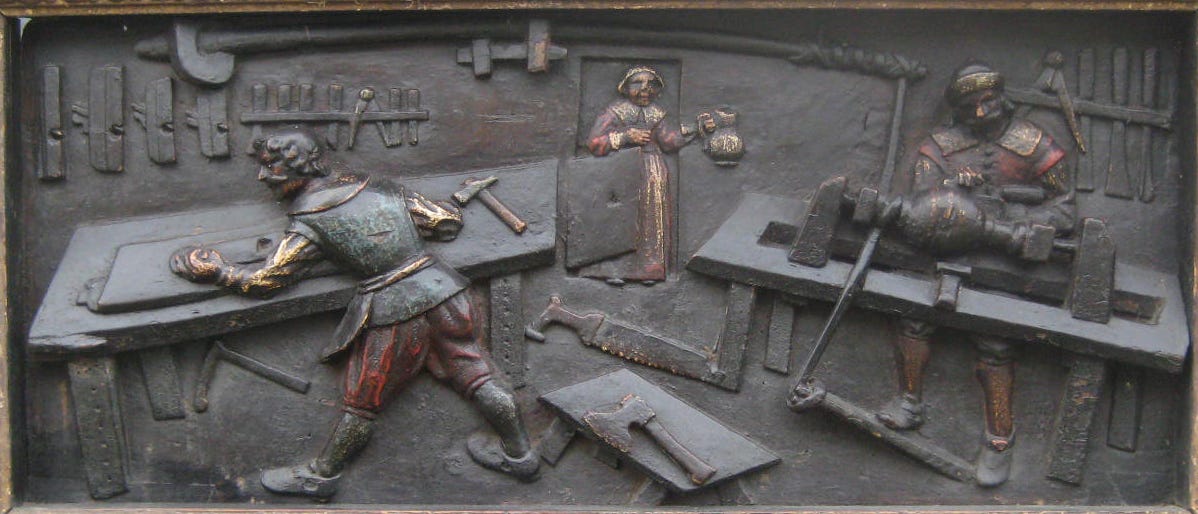
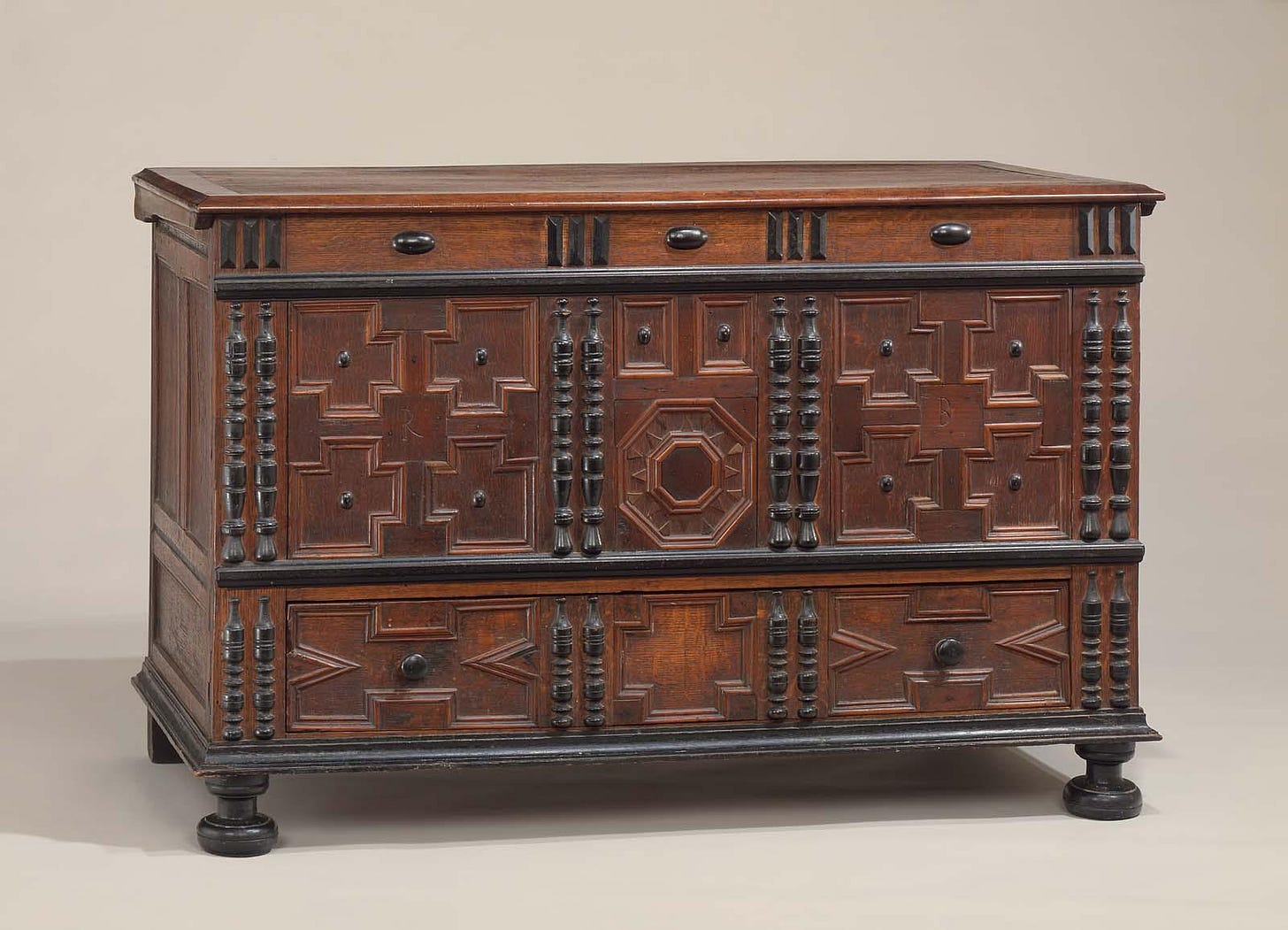
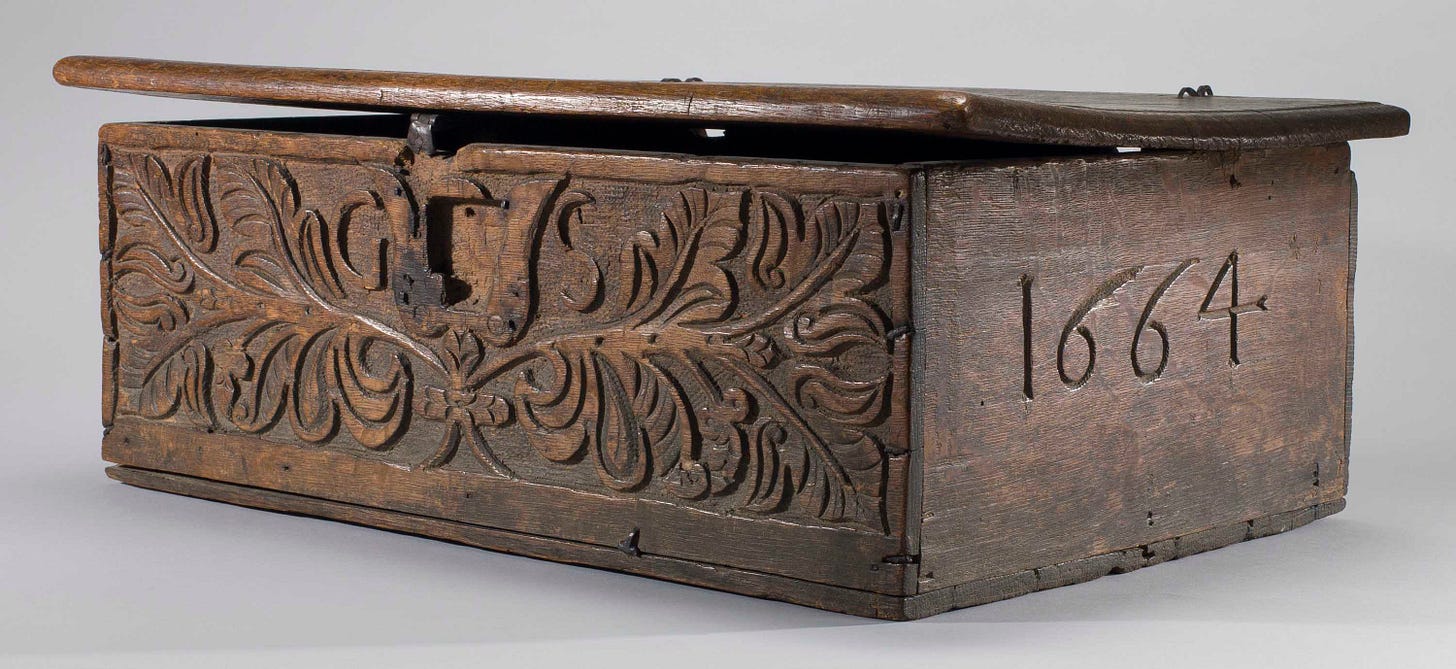
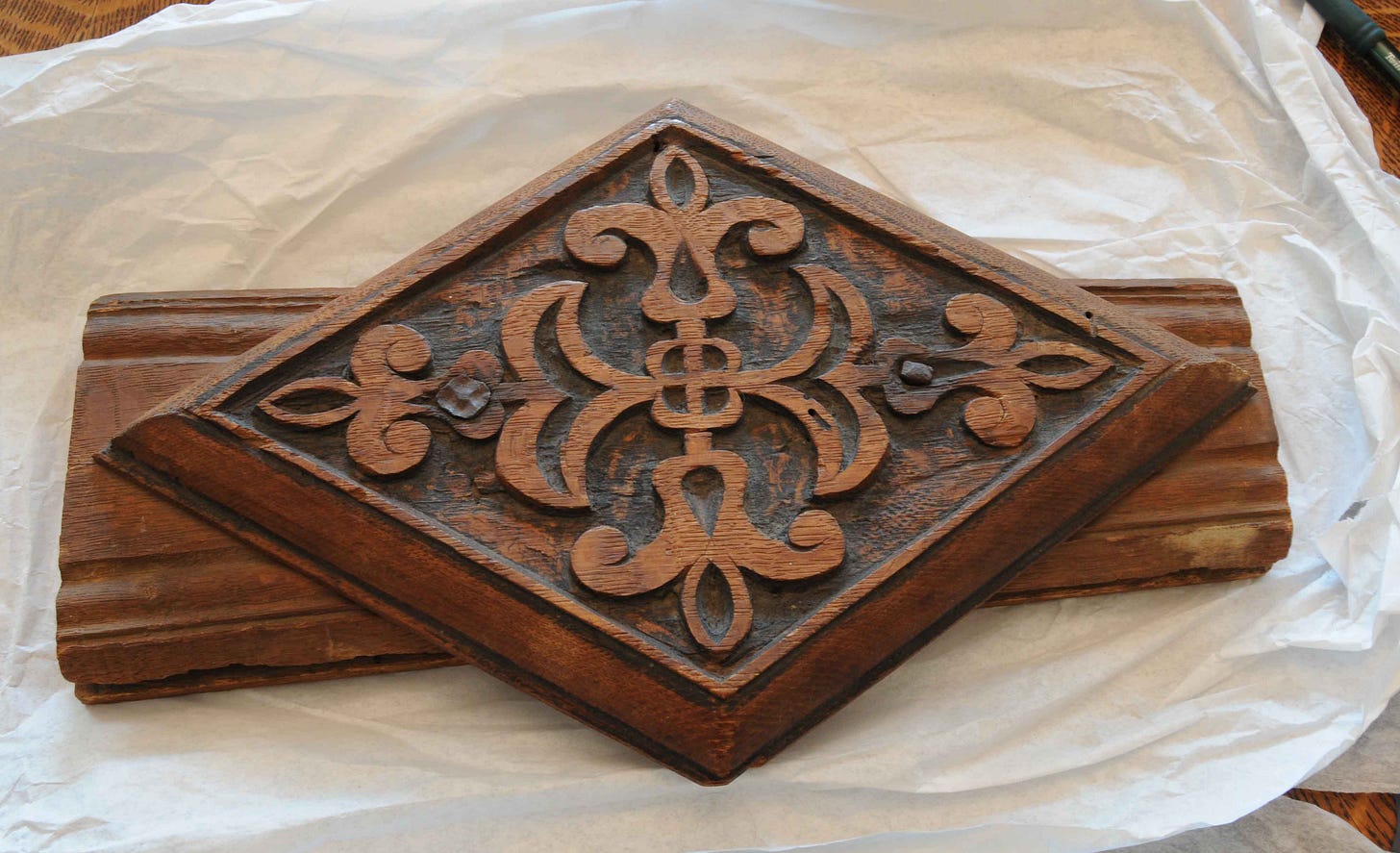
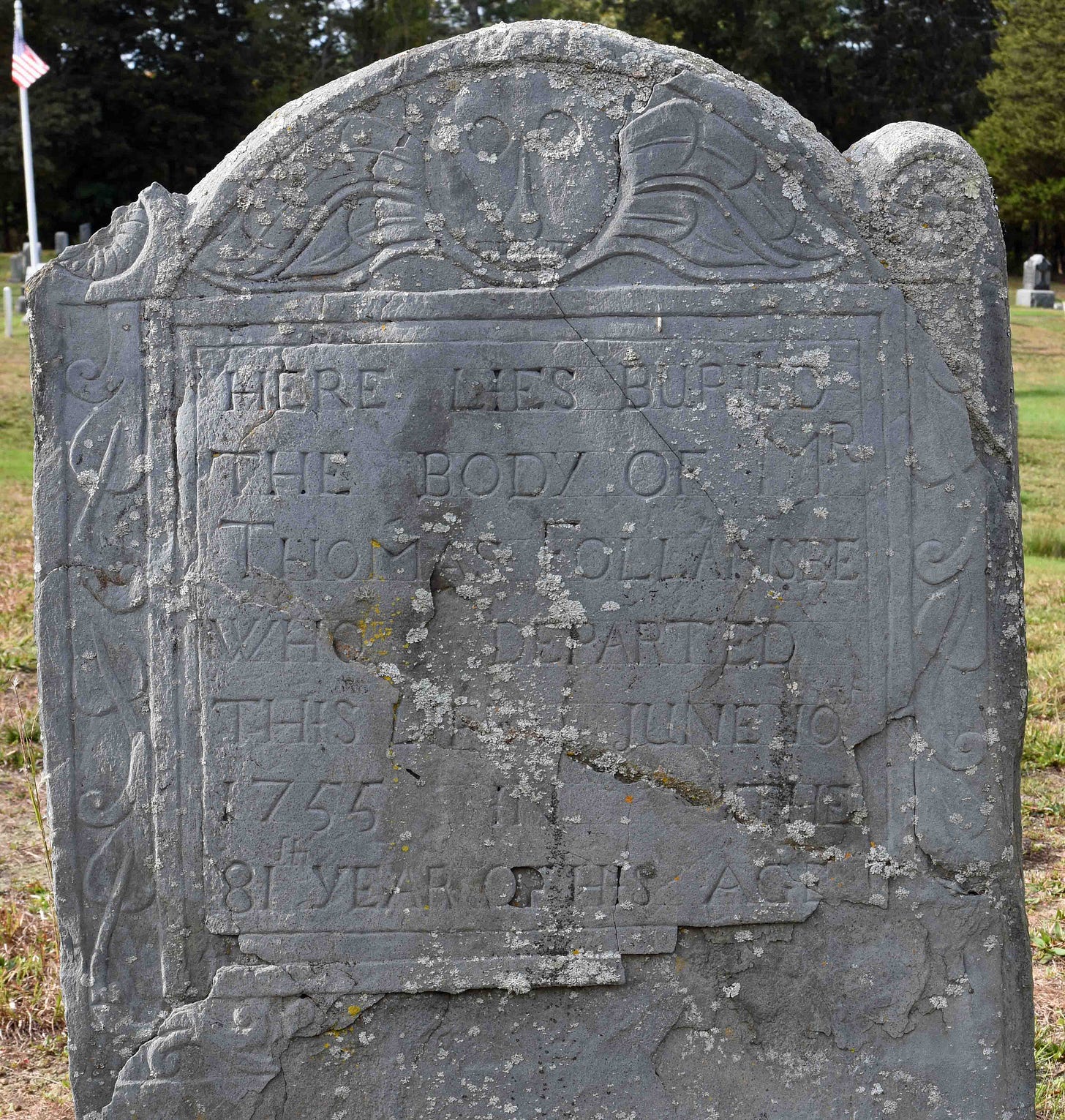
Real Joyners and Carpenters of 17th Century New England beats the hell out of real housewives anywhere or any time.
Interesting to see Thomas Follansbee Jr.'s stone. Certain elements remind me of a stone in eastern Ohio that I wrote about last year. A comment by a reader (Gavin) identified the carver of the stone. Both he and the deceased were originally from Massachusetts. Photos and more about it at the post:
https://davidffisher.com/2024/08/08/angels-head-gravestone/